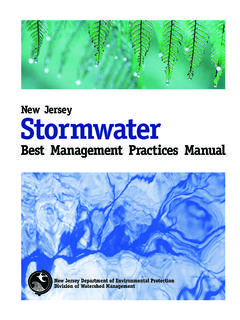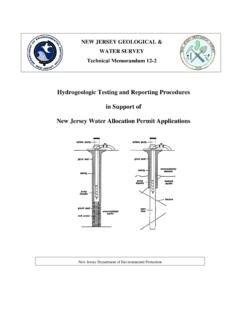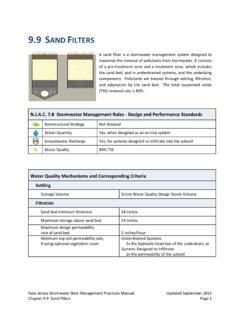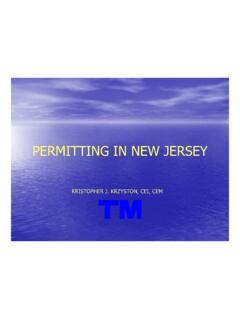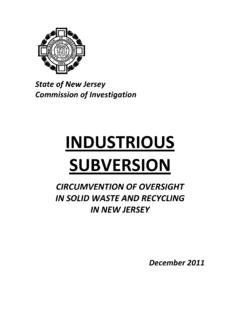Transcription of New Jersey Fishing and Aquaculture: Harvesting …
1 New Jersey Fishing and aquaculture : Harvesting the Garden State s Waters Introduction For over 300 years, New Jersey s commercial fishermen have been bringing home some of the finest fish and shellfish caught anywhere in the world. The burgeoning seafood industry that grew up along the state s coastline shaped how a large part of the landscape would come to look, as Fishing villages later evolved into the familiar towns of the Jersey Shore, often with the seafaring life at their core. Look around those towns, known more today for the tourists they reel in than the fish brought ashore, and you can still find the hard-working fishermen and aquaculturalists making their living from the bounty of the waters. Far from the salty seadogs portrayed on celluloid, today s fishermen are apt to know as much about conservation and the life cycles of various fish as they do about hooks, lines and nets.
2 They are keenly aware that over- Fishing will bring problems for their business, so they do their best to ensure there will be an ample supply of a variety of species in the future. Last year alone, over 100 different species of finfish and shellfish were harvested in the Garden State. Local product is shipped to some of the most discerning seafood markets in the world. New Jersey monkfish are on display at wholesale markets in Seoul, South Korea. New Jersey tuna is sliced in sushi bars in Tokyo. New Jersey squid is served in tapas restaurants in Madrid. In 2003, New Jersey boats brought in over 170 million pounds of fish, valued at over $120 million paid to fishermen at the dock. Clearly, the Harvesting of seafood has played an important role in New Jersey s history.
3 But Fishing and aquaculture are more than just a part of the state s heritage. Six major Fishing ports are located in this state Atlantic City, Barnegat Light, Belford, Cape May, Point Pleasant and Port Norris with a commercial fleet of more than 1,500 vessels employing nearly 3,000 fishermen. New Jersey also boasts 15 seafood processing plants and 81 wholesalers employing more than 2,200 workers. Working the waters -- then and now A visit to the Viking Village seaport in Barnegat Light shows just how much the work of those who bring in the bounty of the sea remains a part of everyday life. The Village, a bustling operation on the northern tip of Long Beach Island, is currently home to 38 Fishing boats, the most the business has ever seen. On any given day, vessels like the Virginia Lynn are preparing to head out to sea.
4 The crews of these large Fishing boats employ a number of techniques. Some are long-liners, who drag lines with hooks spaced far apart. Others are dredges, with nets on frames used for gathering shellfish. Whatever their method, the captains and crews of these vessels know the pressure is on to remain viable. Increasing global competition has turned making the most of each voyage into a necessity. As Ernie Panacek, general manager of Viking Village put it: Because you have to compete with more people in the business, you need a better, higher-quality product. The net result is an emphasis on more boats making shorter trips and bringing their catch home faster. This cuts the time between catch and consumption, giving consumers a better-tasting, safer and higher-quality product than ever before.
5 Like many ports, Fishing communities in New Jersey are defined not only by shared commitment to and dependence on Fishing , but also by a high degree of kinship. Fourth- and fifth-generation fishermen can be found at our ports as well as newcomers from other Fishing nations. The value of the seafood harvest extends well beyond the industry itself. The effects of a prosperous seafood industry are felt in other waterfront activities such as shipbuilding, maintenance and repair, support services (equipment, fuel, materials and supplies) and ecotourism. Most importantly, the dollars earned in Fishing communities tend to remain in those communities, adding incrementally to the local economy and in turn strengthening the relationship between the industry and its home port.
6 Growing urbanization, suburban sprawl and rapid growth of vacation communities are increasingly pressuring not only the Fishing and aquaculture industries but also environmental and water quality in the state. This growth leads to competition for open space and skyrocketing real estate costs and taxes. As in the past, the industry must adapt to its changing surroundings. Clearly, the men and women working in New Jersey s seafood industry represent the result of evolutionary changes in how the catch makes its way from the oceans and bays to the dinner table. The importance of seafood in diet The diets of American consumers have undergone something of an evolution themselves, and seafood is playing a more prominent role today than in the past. To be sure, Americans spend more time thinking about their food today.
7 No day passes without some new or rehashed information about health-conscious diets and the dangers of obesity. This has led to consumers who are more demanding than ever about the health benefits of what s on their plates. A USDA report in the summer of 2004 urged adding more fish to the diet to assist in reducing Americans waistlines as well as cutting the risk of coronary artery disease. The USDA report recommended that fish containing heart-protecting omega-3 fatty acids should be doubled to two servings a week, at 6 to 8 ounces per serving. Seafood also has the advantage of being convenient, quick and easy to prepare, fitting perfectly with Americans demand for healthy foods that fit into our busy schedules. As these dietary recommendations make their way into consumer demands, it will be even more advantageous to have a thriving seafood industry in New Jersey .
8 As with produce and other agricultural products, consumers prefer fish that is as fresh as it can be, making the existence of an abundant local supply crucial. Planning for the future The information in the following report illustrates that it is not only nostalgia that dictates New Jersey do all it can to preserve and enhance its seafood industry, but also sound economic logic. Clearly, embracing aquaculture and Fishing as integral parts of the state s agricultural output is good for all of New Jersey . That is why the New Jersey Department of Agriculture has embarked upon a marketing program to support this important sector of our agricultural community. Through branding as Jersey Seafood those products caught or cultivated here, producers can assure consumers that this seafood is supremely fresh, as well as meeting new national requirements for labeling seafood s country of origin and method of production.
9 With the right assistance, New Jersey s seafood industry should enjoy a healthy future, just as it has enjoyed a rich heritage. New Jersey s Six Major Ports Rich Histories, Richer Futures Belford Point Pleasant Barnegat Light Atlantic City Port Norris
10 Cape May New Jersey s six major Fishing ports share a common development. Originally, each was home to Native American tribes Harvesting finfish and shellfish from nearby waters. Next came the European settlers, Harvesting the waters for their own food. They also saw the economic opportunity in catching even more and selling it in nearby cities such as Philadelphia and Wilmington. After decades as Fishing centers, during which related businesses like boat-building sprung up, most of the ports also developed a significant tourist trade, creating both a customer base and a nuisance as tourism development put further pressures on natural resources. Eventually, environmental concerns such as over- Fishing and natural diseases would force the fishermen to adapt to changing conditions.
